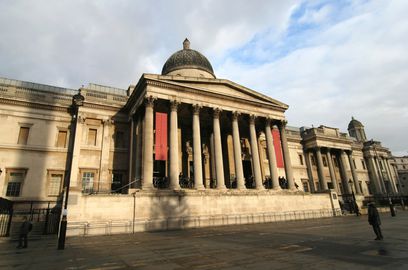

While the frontage of the National Gallery is extremely impressive, its real treasures lie within. That's beyond the scope of this excursion, but we strongly encourage you to make time for a visit now or later! There used to be a busy road between Trafalgar Square and the National Gallery – but in 2003 it was closed, and the northern end of the square attractively pedestrianized, in plans by the famous British architect Lord Norman Foster and WS Atkins. The magnificent facade of the National Gallery, designed by William Wilkins in 1832, is something of a visual trick – because there is no such magnificent building behind it. The facade was built to unite a number of different buildings which were used to house the collection when it was founded in the 1820s, and the buildings have been almost constantly changed and expanded behind Wilkins's facade since then. Unlike many of Europe's national art collections, Britain's National Gallery was not formerly a private collection, or the home of a nobleman – both the gallery and its collections were begun from scratch in the 1820s, because it was felt Britain need a gallery as good as those in other countries. In 1991 the gallery was expanded with the building of the Sainsbury Wing – sponsored by the owners of the supermarket chain, although it didn't please everyone. Prince Charles was very annoyed by it.
Because the gallery's collection was purchased according to a careful plan, it covers almost all periods and styles of art. The heart of the collection is European art of the 15th century to 20th century. Famous works include those by Leonardo da Vinci (3 canvases), Michelangelo, Titian, Holbein, Caravaggio, Rubens, Poussin, and Velazquez. The British artists on display include Gainsborough, Stubbs, Turner and Constable, but frankly they are better represented at the Tate Britain gallery near Pimlico station. What you shouldn't miss are the Hogarth pictures, including the series called 'Marriage a la Mode” – a cycle of paintings depicting personal disasters that result from marrying for money. It is widely regarded as his finest piece of social commentary – drawing on ideas he had previously worked in the series 'The Harlot's Progress'. The National Gallery has an award-winning restaurant, if you feel a bit hungry along your way. Although all of London's concert halls closed for the duration of World War Two, concerts were given at the National Gallery, on an entirely voluntary basis. The concerts were organized by the pianist Myra Hess, who never realized when she began that there would 1700 concerts, with never a day missed. The concerts were at lunchtime, since the wartime regulations forbade lighting in the evenings. Huge numbers of people attended – mostly government staff working in Whitehall offices nearby. Hess was made a Dame of the British Empire for her work.